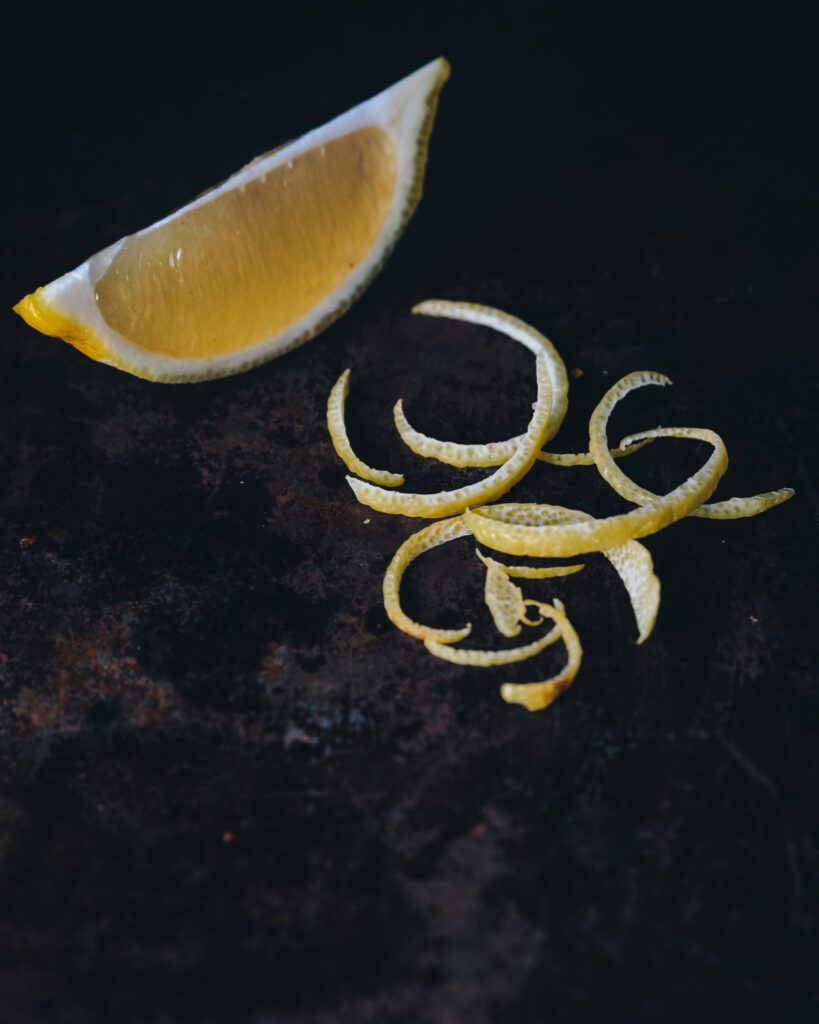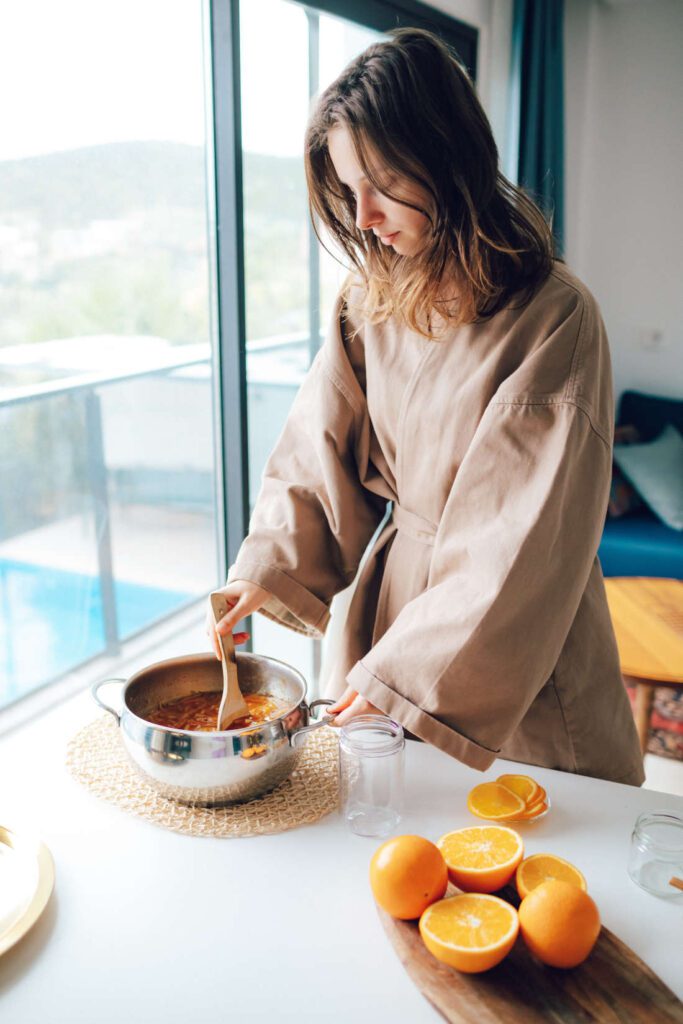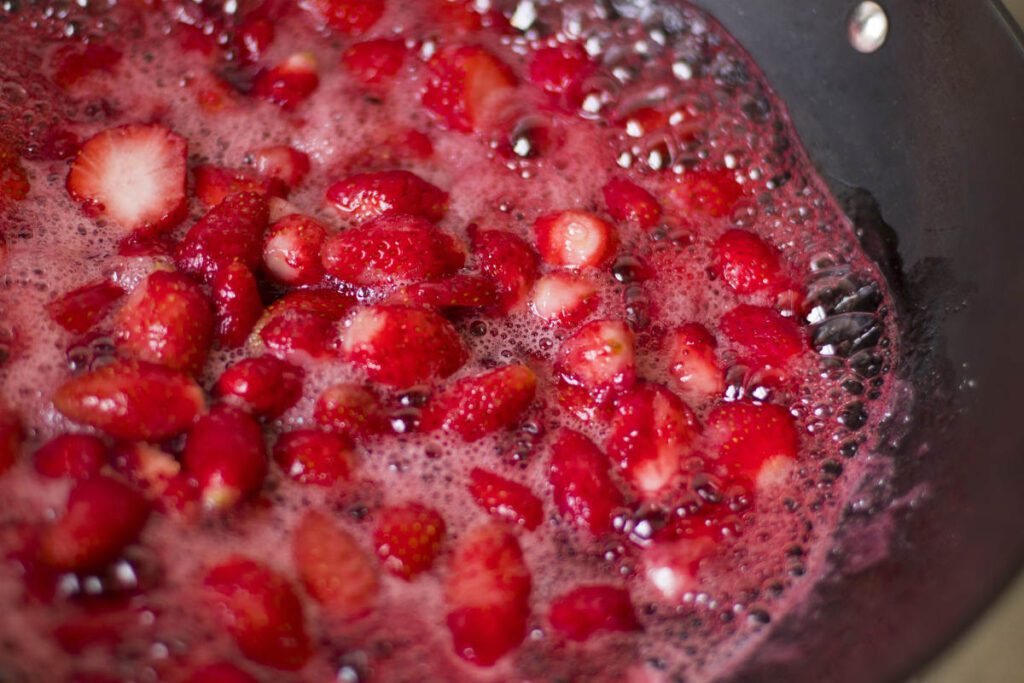In the fascinating world of homemade jams and jellies, the sweet aroma of simmering fruits and sugar can fill your kitchen, but this is also where mishaps and challenges are part of the journey. Fear not, fellow preserve enthusiasts, hiccups like having an odd-tasting jam are common and can happen to anyone who dares to make their own.

Sometimes there’s a clear cause for the issue, while other times, it might be a mysterious combination of variables that come together to create an unexpected outcome.
The good news is that many of these issues can be remedied or partially resolved, allowing you to salvage your creation or find alternative ways to use it. However, in some cases, you may need to discard the jam or jelly, especially if it’s mouldy, and chalk it up to experience.
Learning and experimenting are integral parts of the process. You’ll discover new flavour combinations and techniques, some of which will be a revelation, while others may fall short of your expectations. But don’t let these experiences deter you from continuing to create your own preserves, as each trial brings valuable insights to help you improve and refine your skills.
So, read on to discover what an odd-tasting jam might be about.
Jam/Jelly Tastes bitter, sour or bland
Problem:
Some of the causes of this odd tasting jam can include:
Sugar issue
- When the sugar has not been stirred through.
- The sugar is not thoroughly dissolved and is not cooked long enough.
- Radically reducing the amount of sugar can also compromise the taste especially if the fruit used is not particularly sweet.
Pectin problem
- If pectin is not cooked correctly, it can create a sour or bitter aftertaste in the jam/jelly.

- Another reason the jam/jelly might taste bitter is due to the type of fruit used. Some fruits, like lemons and grapefruits, naturally have a bitter flavour profile. Especially if the peels, with the white pith(where the bitterness lives), are included in the mixture.
Unripe fruits can often be tart or sour, which can translate to a bitter taste in the jam/jelly.
Burned jam
- One major reason that the jam/jelly tastes bitter is that it was scorched or burned during the cooking process. Sometimes when this happens only slightly the burnt sugar can take on a caramel-like flavour which may add something to the taste of the preserve. But when sugar is seriously burned, it can give the jam/jelly a bitter taste sometimes with the addition of burnt black flecks throughout the jam/jelly… (I have been there!).
Remedy
- For the sugar and pectin issues, first, follow the recipe and its recommended proportions. Use a recipe for a low-sugar version of the jam/jelly instead of just guessing how much to leave out. Stir the sugar and pectin through the mixture and ensure that it dissolves completely.
- For specific fruits that have the inbuilt potential for bitterness (like citrus fruits), it is important to use a recipe that balances this with enough sugar or another sweetener to offset the bitterness of the fruit. You can also choose how little or how much of the peel and pith to include to manage the bitterness. (Remember some bitterness is a characteristic of marmalades.)

- When a recipe requires the zest of citrus fruits as an ingredient, try to ensure that you only grate off the outer peel and none, or minimum, white pith where the bitter taste lives.
- Use only riper fruits when making these types of products.
- To avoid scorching or burning make sure that you stir the mixture regularly together. Also actively manage the level of heat.
If it starts to stick, take it off the heat!
With scorching or burnt bits or smell, take it off the heat, do NOT stir vigorously as you will dislodge the burnt bits into and throughout the jam.
With luck, you may be able to rescue the upper layers of unburnt jam to ladle into jars. The resulting jam may have a leftover smoky taste. Just pretend that this is a feature… Unfortunately, you cannot undo this effect, you can only try to stir more and manage the heat more closely next time.
Jam/Jelly is Grainy
Problem:
Ah, the sweet satisfaction of homemade jam. Only to be marred by the unwelcome and gritty texture that leaves your taste buds perplexed. This common odd tasting jam problem is faced by many home cooks in their quest for the perfect spread.
Reasons why your jam might be grainy:
Using under ripe or overripe fruit:
The ripeness of the fruit plays a crucial role in determining the texture of your jam or jelly. Underripe fruits contain a higher amount of pectin, which can contribute to a grainy texture if not broken down properly during cooking.
On the other hand, overripe fruits have less pectin, which may result in a runnier consistency and potentially cause sugar crystals to form more easily. Moreover, overripe fruits can have a higher concentration of natural sugars, making it more challenging to dissolve added sugar evenly.
Also, if the fruit has seeds, like strawberries, raspberries and gooseberries, for example, this may result in a grainy texture when eating it. Some people do not like this!
Not cooking the jam long enough:

Cooking time is essential for achieving the desired consistency in your jam or jelly. If the jam is not cooked long enough, the sugar may not dissolve completely. Then undissolved sugar crystals is experienced as a grainy texture. Which is odd when not expected!
Additionally, insufficient cooking time prevents the pectin from setting correctly, which also contributes to a less-than-satisfactory texture.
Uneven sugar distribution:
When sugar is not evenly distributed throughout the jam or jelly mixture, it can lead to undissolved sugar crystals, resulting in a grainy texture.
It’s essential to stir the mixture frequently while it’s cooking. Make sure that the sugar dissolves uniformly and does not settle at the bottom of the pot.
Such crystals can also be found in the jam if you clean down the side of the preserving pan with a spatula just before ladling it into the jars. Of course, you want to get every tasty drop of the jam. But undissolved sugar or hardened splatter stuck on the sides of the pan may then get into the finished product.
The type of sugar used in the recipe:

Granulated sugar, which is commonly used in recipes, has larger crystals that may take longer to dissolve. This can then potentially causing a grainy texture if not dissolved completely. So this needs to be stirred more thoroughly to encourage it to dissolve.
Some recipes use, or you may choose, alternative sweeteners like honey or agave. These may react differently with the pectin and fruit, resulting in a different texture.
Remedy:
There are some ways to tackle this odd tasting jam problem. This can help ensure that your homemade jam has the smooth, luscious consistency you desire.
- Make sure you’re using ripe fruit, as it will break down more easily during cooking.
- Allow more liquid and a longer cooking time for unripe fruits. This can balance out both their need for more time to break down and still keep a rein on the potentially higher concentration of pectin.
- Stir the mixture frequently and thoroughly to ensure an even distribution of sugar.

- Consider using finer sugar, like caster sugar, to help dissolve the crystals more efficiently.
- Try blending and/or straining the fruit beforehand to ensure a smoother texture from the get-go. This can limit seeds and help the fruit and sugar mixture to dissolve into each other.
- Avoid scraping down the sides of the preserving pan when filling your jam jars. This can limit hardened splatters of jam or sugar from becoming part of the spread.
With these tips in mind, you’ll be well on your way to a silky, delectable homemade jam that spreads like a dream on your morning toast.

There may be various hurdles that you may encounter before, during, and after making your sweet preserves, and while some of these experiences may feel discouraging, they’re certainly no reason to feel disheartened or consider your efforts a failure.
Embrace the learning curve and continue experimenting with new techniques, flavours, and methods in the pursuit of your ideal homemade jams or jellies. Each challenge you overcome will only serve to develop your skills and confidence in the kitchen. With patience, practice, and perseverance, you’ll soon be creating delectable preserves that not only bring joy to your taste buds but also become cherished gifts for your loved ones and friends.
Savour each success and let each setback be a stepping stone towards mastery. After all, the sweetest rewards often come from the lessons learned along the way. Happy preserving!